Abstract
The bilrubin-IXalpha conjugates in bile and the activities of bilirubin-IX alpha--UDP-glycosyltransferases in liver and kidney were determined for ten species of mammals and for the chicken. 1. In the mammalian species, bilirubin-IX alpha glucuronide was the predominant bile pigment. Excretion of neutral glycosides was unimportant, except in the cat, the mouse, the rabbit and the dog, where glucose and xylose represented 12--41% of total conjugating groups bound to bilirubin-IX alpha. In chicken bile, glucoside and glucuronide conjugates were of equal importance. They probably represent only a small fraction of the total bile pigment. 2. The transferase activities in liver showed pronounced species variation. This was also apparent with regard to activation by digitonin, pH optimum and relative activities of transferases acting on either UDP-glucuronic acid or neutral UDP-sugars. 3. Man, the dog, the cat and the rat excrete bilirubin-IX alpha largely as diconjugated derivatives. In general, diconjugated bilirubin-IX alpha could also be synthesized in vitro with liver homogenate, bilirubin-IX alpha and UDP-sugar. In contrast, for the other species examined, bilirubin pigments consisted predominantly of monoconjugated bilirubin-IX alpha. Synthesis in vitro with UDP-glucuronic acid, UDP-glucose or UDP-xylose as the sugar donor led exclusively to the formation of monoconjugated bilirubin-IX alpha. 4. The transferase activities in the kidney were restricted to the cortex and were important only for the rat and the dog. No activity at all could be detected for several species, including man. 5. Comparison of the transferase activities in liver with reported values of the maximal rate of excretion in bile suggests a close linkage between conjugation and biliary secretion of bilirubin-IX alpha.
Full text
PDF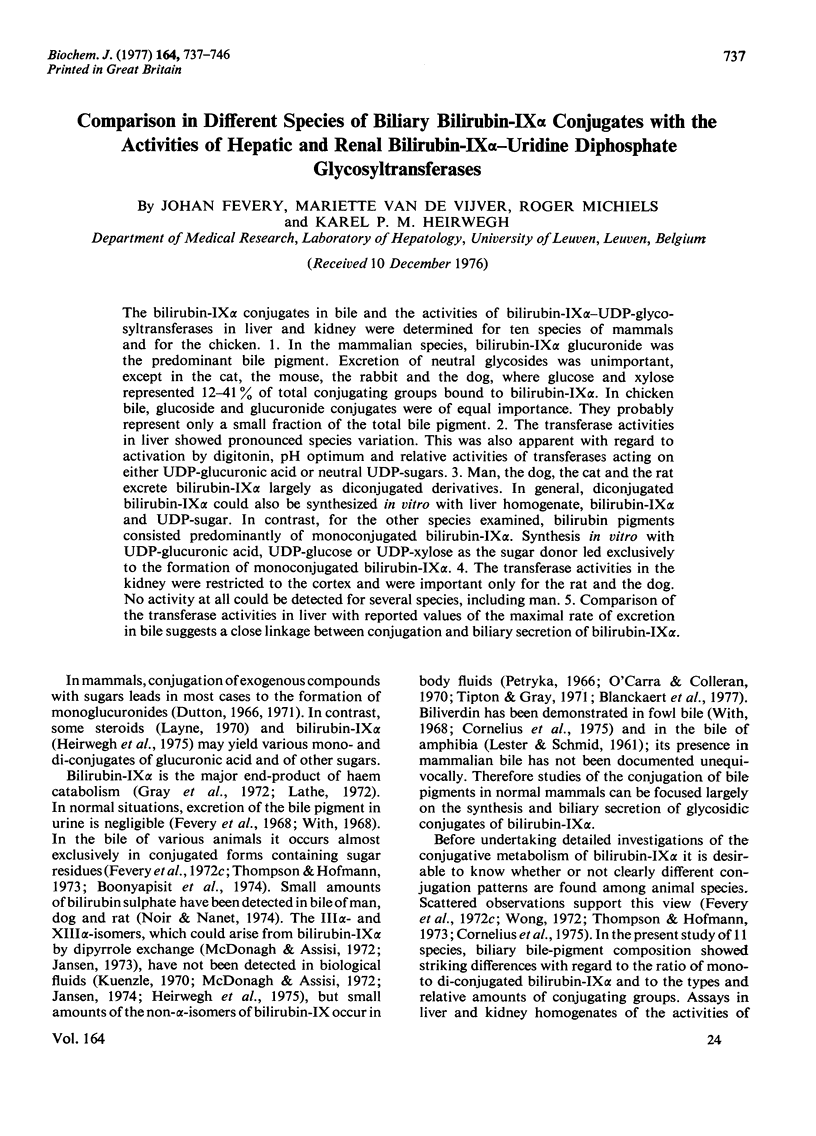
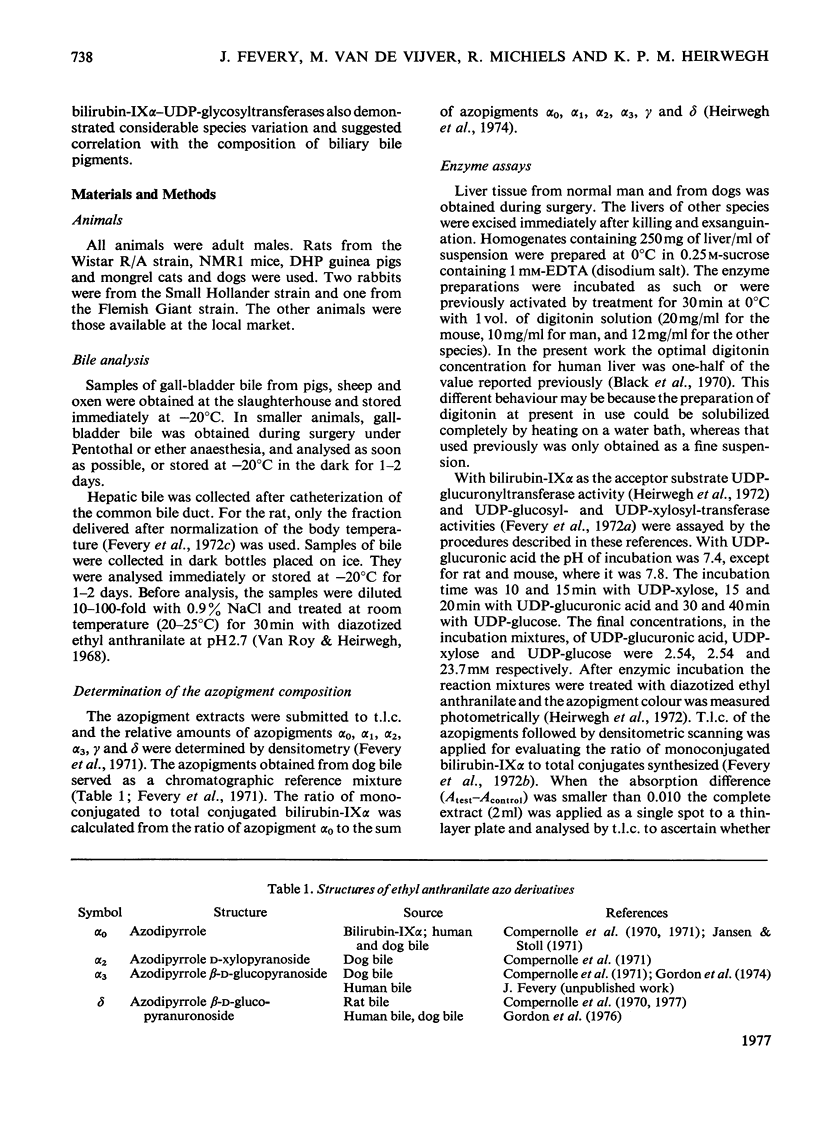

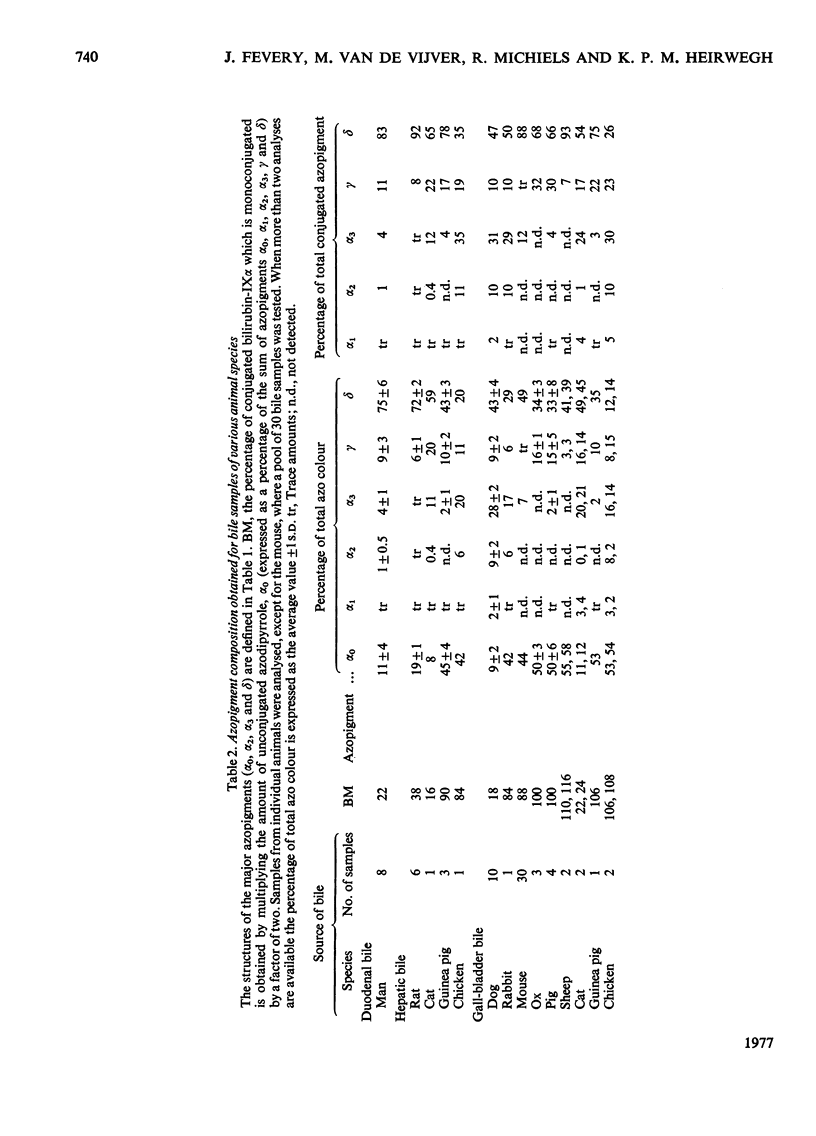
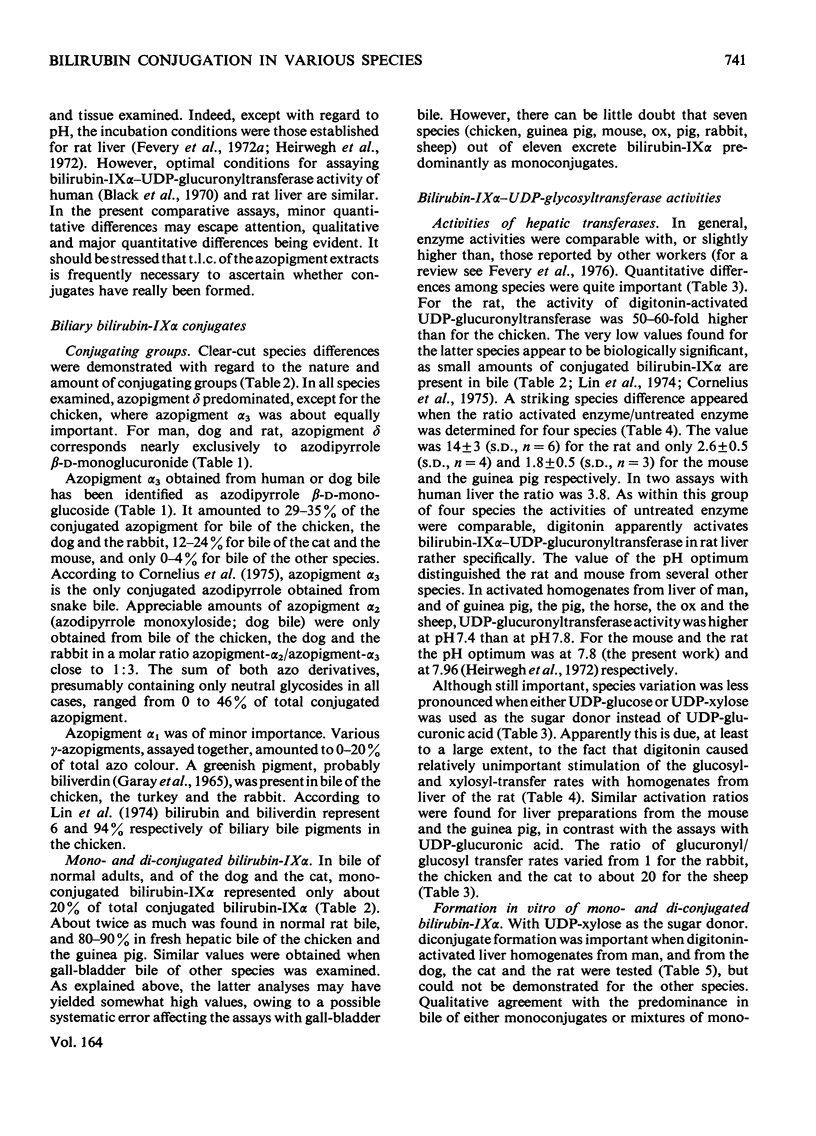
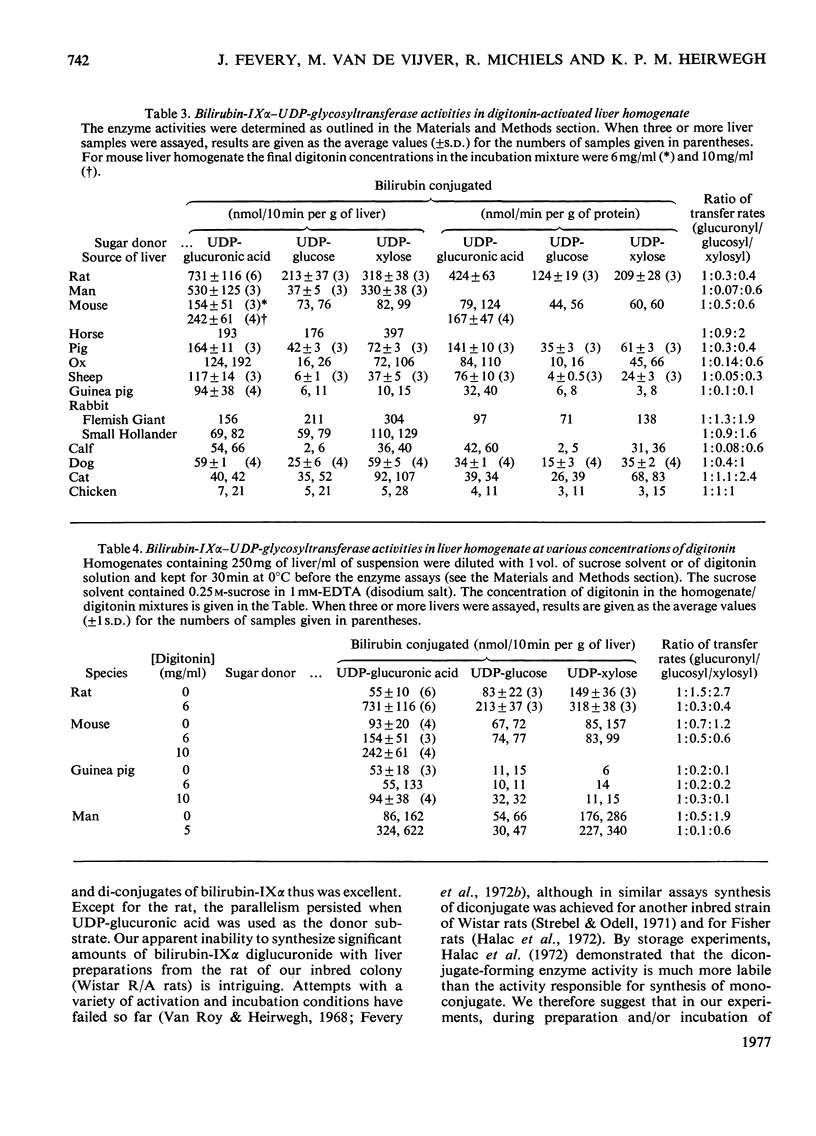
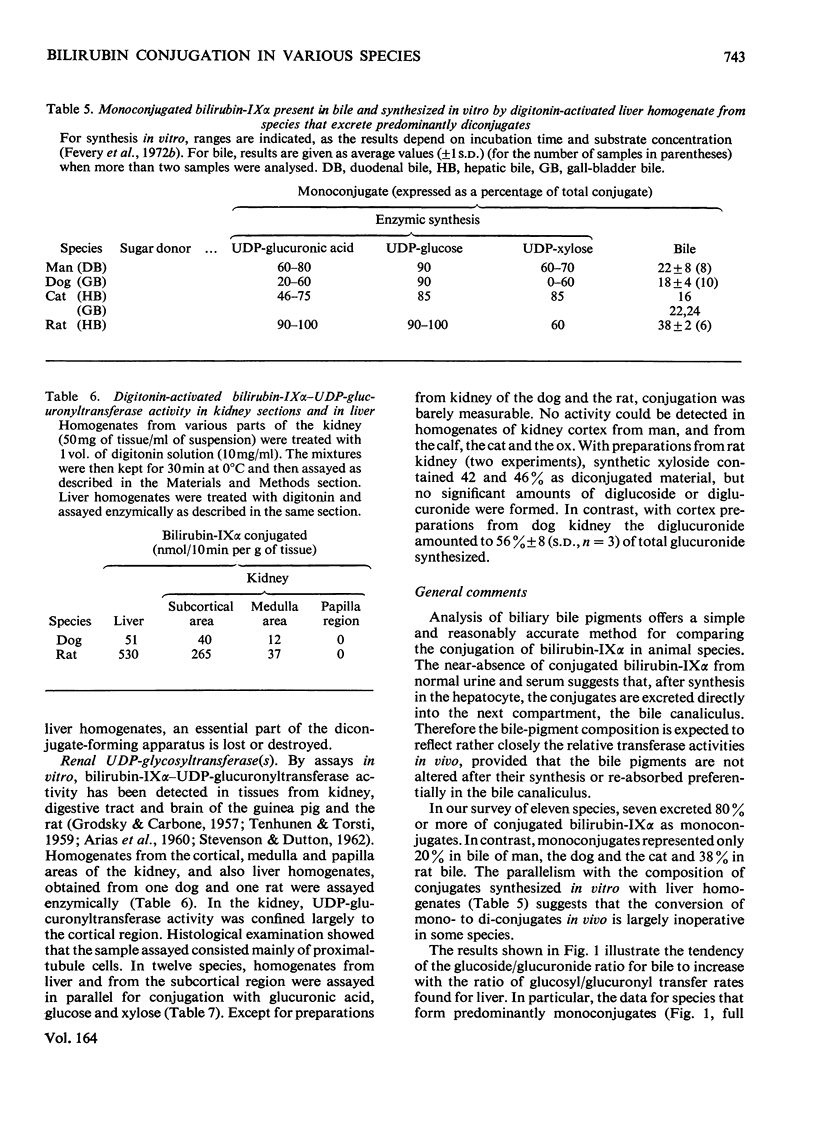
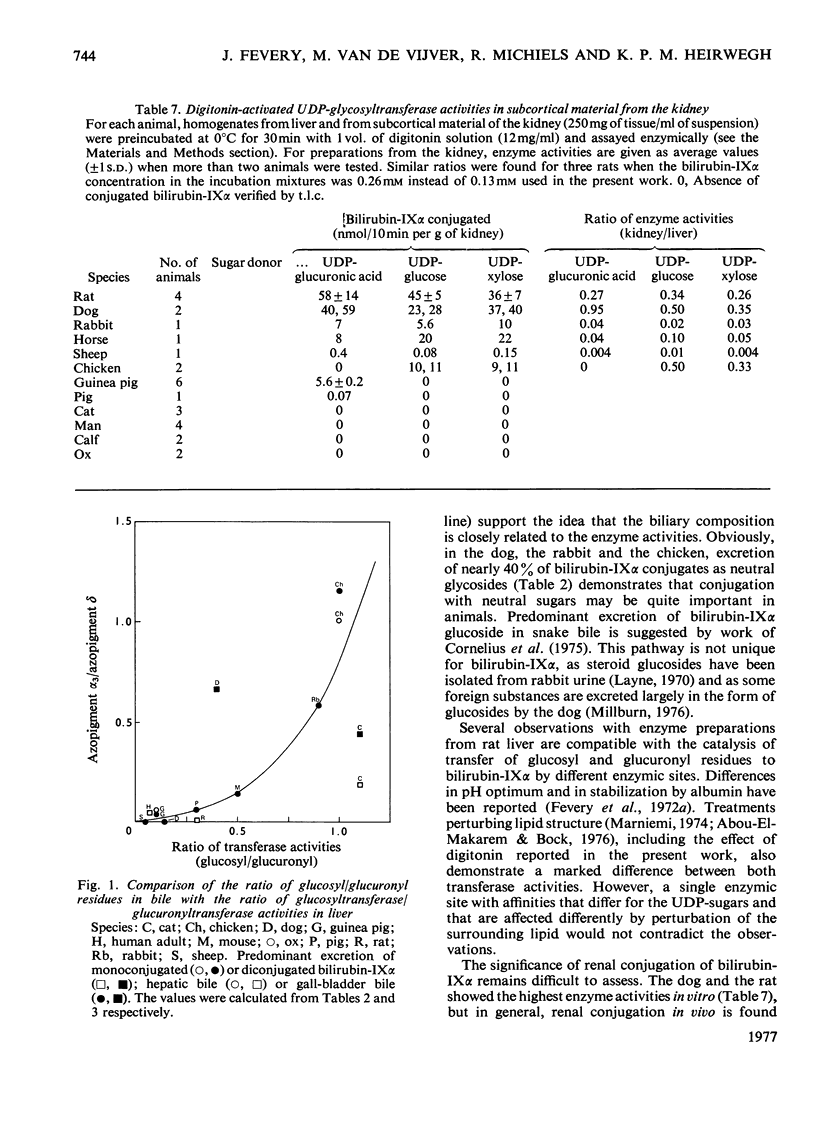
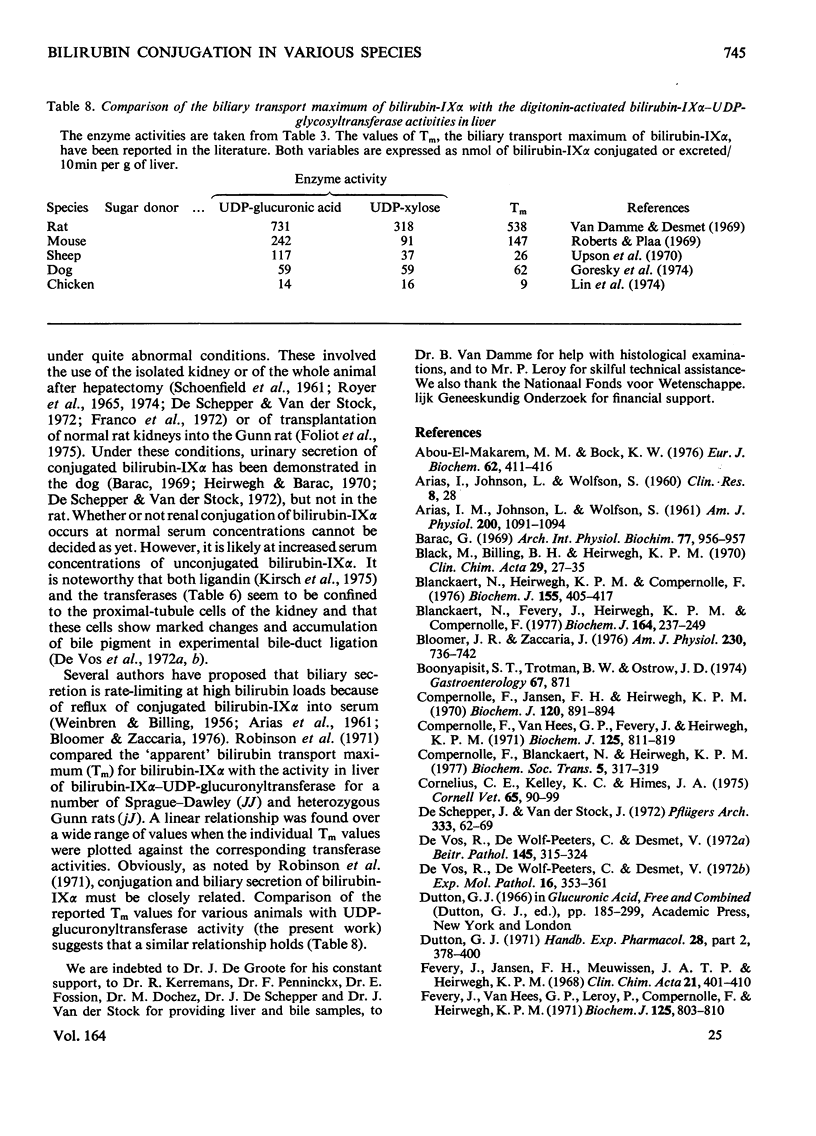
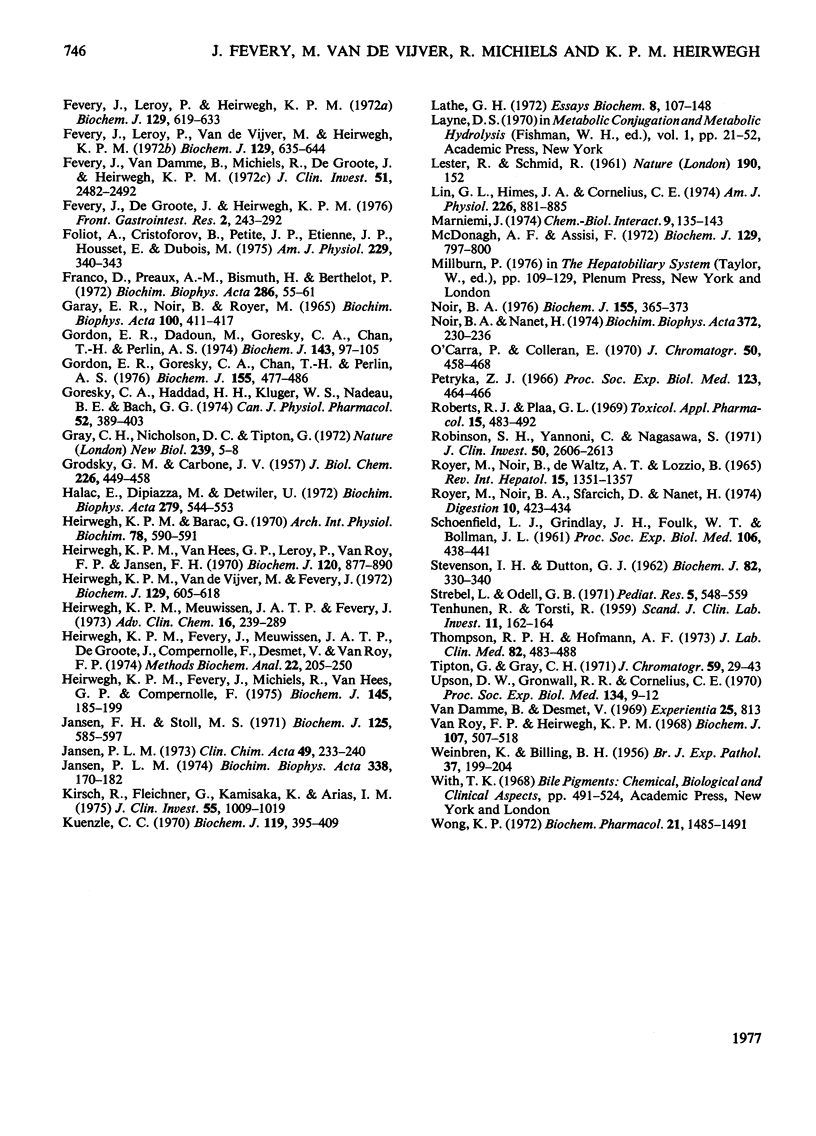
Selected References
These references are in PubMed. This may not be the complete list of references from this article.
- ARIAS I. M., JOHNSON L., WOLFSON S. Biliary excretion of injected conjugated and unconjugated bilirubin by normal and Gunn rats. Am J Physiol. 1961 May;200:1091–1094. doi: 10.1152/ajplegacy.1961.200.5.1091. [DOI] [PubMed] [Google Scholar]
- Abou-El-Makarem M. M., Bock K. W. UDP-glucuronyltransferase in perfused rat liver and in microsomes. Glucuronidation of bilirubin. Eur J Biochem. 1976 Feb 16;62(2):411–416. doi: 10.1111/j.1432-1033.1976.tb10173.x. [DOI] [PubMed] [Google Scholar]
- Barac G. State of unconjugated plasma bilirubin "in vivo". Arch Int Physiol Biochim. 1969 Dec;77(5):956–957. [PubMed] [Google Scholar]
- Black M., Billing B. H., Heirwegh K. P. Determination of bilirubin UDP-glucuronyl transferase activity in needle-biopsy specimens of human liver. Clin Chim Acta. 1970 Jul;29(1):27–35. doi: 10.1016/0009-8981(70)90216-0. [DOI] [PubMed] [Google Scholar]
- Blanckaert N., Fevery J., Heirwegh K. P., Compernolle F. Characterization of the major diazo-positive pigments in bile of homozygous Gunn rats. Biochem J. 1977 Apr 15;164(1):237–249. doi: 10.1042/bj1640237. [DOI] [PMC free article] [PubMed] [Google Scholar]
- Blanckaert N., Heirwegh K. P., Compernolle F. Synthesis and separation by thin-layer chromatography of bilirubin-IX isomers. Their identification as tetrapyrroles and dipyrrolic ethyl anthranilate azo derivatives. Biochem J. 1976 May 1;155(2):405–417. doi: 10.1042/bj1550405. [DOI] [PMC free article] [PubMed] [Google Scholar]
- Bloomer J. R., Zaccaria J. Effect of graded bilirubin loads on bilirubin transport by perfused rat liver. Am J Physiol. 1976 Mar;230(3):736–742. doi: 10.1152/ajplegacy.1976.230.3.736. [DOI] [PubMed] [Google Scholar]
- Compernolle F., Blanckaert N., Heirwegh K. P. The fate of bilirubin-IXalpha glucuronides in cholestatic bile: sequential migration of the 1-acylaglycone to the 2-, 3- and 4- positions of glucuronic acid. Biochem Soc Trans. 1977;5(1):317–319. doi: 10.1042/bst0050317. [DOI] [PubMed] [Google Scholar]
- Compernolle F., Jansen F. H., Heirwegh K. P. Mass-spectrometric study of the azopigments obtained from bile pigments with diazotized ethyl anthranilate. Biochem J. 1970 Dec;120(4):891–894. doi: 10.1042/bj1200891. [DOI] [PMC free article] [PubMed] [Google Scholar]
- Compernolle F., Van Hees G. P., Fevery J., Heirwegh K. P. Mass-spectrometric structure elucidation of dog bile azopigments as the acyl glycosides of glucopyranose and xylopyranose. Biochem J. 1971 Dec;125(3):811–819. doi: 10.1042/bj1250811. [DOI] [PMC free article] [PubMed] [Google Scholar]
- Cornelius C. E., Kelley K. C., Himes J. A. Heterogeneity of bilirubin conjugates in several animal species. Cornell Vet. 1975 Jan;65(1):90–99. [PubMed] [Google Scholar]
- De Vos R., De Wolf-Peeters C., Desmet V. Electron microscopy of the tubule cells of rat kidney after experimental bile duct ligation. Exp Mol Pathol. 1972 Jun;16(3):353–361. doi: 10.1016/0014-4800(72)90010-x. [DOI] [PubMed] [Google Scholar]
- De Vos R., De Wolf-Peeters C., Desmet V. Histochemical changes in rat kidney after bile duct obstruction. Beitr Pathol. 1972;145(4):315–324. [PubMed] [Google Scholar]
- Fevery J., Jansen F. H., Meuwissen J. A., Heirwegh K. P. Bilirubin-like material in urine of normal adults. Clin Chim Acta. 1968 Sep;21(3):401–410. doi: 10.1016/0009-8981(68)90068-5. [DOI] [PubMed] [Google Scholar]
- Fevery J., Leroy P., Heirwegh K. P. Enzymic transfer of glucose and xylose from uridine diphosphate glucose and uridine diphosphate xylose to bilirubin by untreated and digitonin-activated preparations from rat liver. Biochem J. 1972 Sep;129(3):619–633. doi: 10.1042/bj1290619. [DOI] [PMC free article] [PubMed] [Google Scholar]
- Fevery J., Leroy P., Van de Vijver M., Heirwegh K. P. Structures of bilirubin conjugates synthesized in vitro from bilirubin and uridine diphosphate glucuronic acid, uridine diphosphate glucose or uridine diphosphate xylose by preparations from rat liver. Biochem J. 1972 Sep;129(3):635–644. doi: 10.1042/bj1290635. [DOI] [PMC free article] [PubMed] [Google Scholar]
- Fevery J., Van Damme B., Michiels R., De Groote J., Heirwegh K. P. Bilirubin conjugates in bile of man and rat in the normal state and in liver disease. J Clin Invest. 1972 Sep;51(9):2482–2492. doi: 10.1172/JCI107062. [DOI] [PMC free article] [PubMed] [Google Scholar]
- Fevery J., Van Hees G. P., Leroy P., Compernolle F., Heirwegh K. P. Excretion in dog bile of glucose and xylose conjugates of bilirubin. Biochem J. 1971 Dec;125(3):803–810. doi: 10.1042/bj1250803. [DOI] [PMC free article] [PubMed] [Google Scholar]
- Fevery J., de Groote J., Heirwegh K. P. Properties of bilirubin UDP-glycosyltransferases. Front Gastrointest Res. 1976;2:243–292. doi: 10.1159/000398598. [DOI] [PubMed] [Google Scholar]
- Foliot A., Christoforov B., Petite J. P., Etienne J. P., Housset E., Dubois M. Bilirubin UDP-glucuronyltransferase activity of wistar rat kidney. Am J Physiol. 1975 Aug;229(2):340–343. doi: 10.1152/ajplegacy.1975.229.2.340. [DOI] [PubMed] [Google Scholar]
- Franco D., Preaux A. M., Bismuth H., Berthelot P. Extra hepatic formation of bilirubin glucuronides in the rat. Biochim Biophys Acta. 1972 Nov 24;286(1):55–61. doi: 10.1016/0304-4165(72)90087-6. [DOI] [PubMed] [Google Scholar]
- GARAY E. R., NOIR B., ROYER M. BILIVERDIN PIGMENTS IN GREEN BILES. Biochim Biophys Acta. 1965 May 4;100:411–417. doi: 10.1016/0304-4165(65)90010-3. [DOI] [PubMed] [Google Scholar]
- GRODSKY G. M., CARBONE J. V. The synthesis of bilirubin glucuronide by tissue homogenates. J Biol Chem. 1957 May;226(1):449–458. [PubMed] [Google Scholar]
- Gordon E. R., Dadoun M., Goresky C. A., Chan T. H., Perlin A. S. The isolation of an azobilirubin beta-D-monoglucoside from dog gall-bladder bile. Biochem J. 1974 Oct;143(1):97–105. doi: 10.1042/bj1430097. [DOI] [PMC free article] [PubMed] [Google Scholar]
- Gordon E. R., Goresky C. A., Chang T. H., Perlin A. S. The isolation and characterization of bilirubin diglucuronide, the major bilirubin conjugate in dog and human bile. Biochem J. 1976 Jun 1;155(3):477–486. doi: 10.1042/bj1550477. [DOI] [PMC free article] [PubMed] [Google Scholar]
- Goresky C. A., Haddad H. H., Kluger W. S., Nadeau B. E., Bach G. G. The enhancement of maximal bilirubin excretion with taurocholate-induced increments in bile flow. Can J Physiol Pharmacol. 1974 Jun;52(3):389–403. doi: 10.1139/y74-055. [DOI] [PubMed] [Google Scholar]
- Gray C. H., Nicholson D. C., Tipton G. Degradation of haem compounds to bile pigments. Nat New Biol. 1972 Sep 6;239(88):5–8. doi: 10.1038/newbio239005a0. [DOI] [PubMed] [Google Scholar]
- Halac E., Dipiazza M., Detwiler P. The formation of bilirubin mono- and diglucuronide by rat liver microsomal fractions. Biochim Biophys Acta. 1972 Oct 25;279(3):544–553. doi: 10.1016/0304-4165(72)90176-6. [DOI] [PubMed] [Google Scholar]
- Heirwegh K. P., Barac G. Urinary bilirubinoids after intravenous injection of unconjugated bilirubin in dogs. Arch Int Physiol Biochim. 1970 Aug;78(3):590–591. [PubMed] [Google Scholar]
- Heirwegh K. P., Fevery J., Meuwissen J. A., De Groote J., Compernolle F., Desmet V., Van Roy F. P. Recent advances in the separation and analysis of diazo-positive bile pigments. Methods Biochem Anal. 1974;22:205–250. doi: 10.1002/9780470110423.ch5. [DOI] [PubMed] [Google Scholar]
- Heirwegh K. P., Fevery J., Michiels R., van Hees G. P., Compernolle F. Separation by thin-layer chromatography and structure elucidation of bilirubin conjugates isolated from dog bile. Biochem J. 1975 Feb;145(2):185–199. doi: 10.1042/bj1450185. [DOI] [PMC free article] [PubMed] [Google Scholar]
- Heirwegh K. P., Meuwissen J. A., Fevery J. Critique of the assay and significance of bilirubin conjugation. Adv Clin Chem. 1973;16:239–288. doi: 10.1016/s0065-2423(08)60347-9. [DOI] [PubMed] [Google Scholar]
- Heirwegh K. P., Van Hees G. P., Leroy P., Van Roy F. P., Jansen F. H. Heterogeneity of bile pigment conjugates as revealed by chromatography of their ethyl anthranilate azopigments. Biochem J. 1970 Dec;120(4):877–890. doi: 10.1042/bj1200877. [DOI] [PMC free article] [PubMed] [Google Scholar]
- Heirwegh K. P., Van de Vijver M., Fevery J. Assay and properties of dititonin-activated bilirubin uridine diphosphate glucuronyltransferase from rat liver. Biochem J. 1972 Sep;129(3):605–618. doi: 10.1042/bj1290605. [DOI] [PMC free article] [PubMed] [Google Scholar]
- Jansen F. H., Stoll M. S. Separation and structural analysis of vinyl- and isovinyl-azobilirubin derivatives. Biochem J. 1971 Nov;125(2):585–597. doi: 10.1042/bj1250585. [DOI] [PMC free article] [PubMed] [Google Scholar]
- Jansen P. L. The isomerisation of bilirubin monoglucuronide. Clin Chim Acta. 1973 Dec 12;49(2):233–240. doi: 10.1016/0009-8981(73)90296-9. [DOI] [PubMed] [Google Scholar]
- Kirsch R., Fleischner G., Kamisaka K., Arias I. M. Structural and functional studies of ligandin, a major renal organic anion-binding protein. J Clin Invest. 1975 May;55(5):1009–1019. doi: 10.1172/JCI108001. [DOI] [PMC free article] [PubMed] [Google Scholar]
- Kuenzle C. C. Bilirubin conjugates of human bile. Nuclear-magnetic-resonance, infrared and optical spectra of model compounds. Biochem J. 1970 Sep;119(3):395–409. doi: 10.1042/bj1190395. [DOI] [PMC free article] [PubMed] [Google Scholar]
- Lathe G. H. The degradation of haem by mammals and its excretion as conjugated bilirubin. Essays Biochem. 1972;8:107–148. [PubMed] [Google Scholar]
- Lin G. L., Himes J. A., Cornelius C. E. Bilirubin and biliverdin excretion by the chicken. Am J Physiol. 1974 Apr;226(4):881–885. doi: 10.1152/ajplegacy.1974.226.4.881. [DOI] [PubMed] [Google Scholar]
- Marniemi J. Bilirubin UDP-glucosyl-and UDP-glucuronosyltransferase of rat liver. A comparative study of the effects of membrane perturbants in vitro and of chrysene administration in vivo. Chem Biol Interact. 1974 Aug;9(2):135–143. doi: 10.1016/0009-2797(74)90005-2. [DOI] [PubMed] [Google Scholar]
- McDonagh A. F., Assisi F. The ready isomerization of bilirubin IX- in aqueous solution. Biochem J. 1972 Sep;129(3):797–800. doi: 10.1042/bj1290797. [DOI] [PMC free article] [PubMed] [Google Scholar]
- Noir B. A. Bilirubin conjugates in bile of man, rat and dog. Semi-quantitative analysis of bile composition by thin-layer chromatography. Biochem J. 1976 May 1;155(2):365–373. doi: 10.1042/bj1550365. [DOI] [PMC free article] [PubMed] [Google Scholar]
- Noir B. A., Nanet H. A study of the ethyl anthranilate azo derivatives of bilirubin sulphate. Confirmation of the existence of bilirubin sulphate conjugates in bile. Biochim Biophys Acta. 1974 Nov 4;372(1):230–236. doi: 10.1016/0304-4165(74)90090-7. [DOI] [PubMed] [Google Scholar]
- O'Carra P., Colleran E. Separation and identification of biliverdin isomers and isomer analysis of phycobilins and bilirubin. J Chromatogr. 1970 Aug 12;50(3):458–468. doi: 10.1016/s0021-9673(00)97973-1. [DOI] [PubMed] [Google Scholar]
- Petryka Z. J. Identification of isomers differing from 9, alpha, in the early labelled bilirubin of the bile. Proc Soc Exp Biol Med. 1966 Nov;123(2):464–466. doi: 10.3181/00379727-123-31515. [DOI] [PubMed] [Google Scholar]
- Roberts R. J., Plaa G. L. Studies on bilirubin production and excretion in mice and rats treated with phenobarbital, chlorpromazine, norethandrolone, acetohexamide or enovid. Toxicol Appl Pharmacol. 1969 Sep;15(2):483–492. doi: 10.1016/0041-008x(69)90046-5. [DOI] [PubMed] [Google Scholar]
- Robinson S. H., Yannoni C., Nagasawa S. Bilirubin excretion in rats with normal and impaired bilirubin conjugation: effect of phenobarbital. J Clin Invest. 1971 Dec;50(12):2606–2613. doi: 10.1172/JCI106761. [DOI] [PMC free article] [PubMed] [Google Scholar]
- Royer M., Noir B. A., Sfarcich D., Nanet H. Extrahepatic bilirubin formation and conjugation in the dog. Digestion. 1974;10(6):423–434. doi: 10.1159/000197555. [DOI] [PubMed] [Google Scholar]
- Royer M., Noir B., de Walz A. T., Lozzio B. Conjugaison de la bilirubine chez le chien hépatectomisé. Rev Int Hepatol. 1965;15(8):1351–1357. [PubMed] [Google Scholar]
- SCHOENFIELD L. J., GRINDLAY J. H., FOULK W. T., BOLLMAN J. L. Identification of extrahepatic bilirubin monoglucuronide and its conversion to pigment 2 by isolated liver. Proc Soc Exp Biol Med. 1961 Feb;106:438–441. doi: 10.3181/00379727-106-26362. [DOI] [PubMed] [Google Scholar]
- STEVENSON I. H., DUTTON G. J. Glucuronide synthesis in kidney and gastrointestinal tract. Biochem J. 1962 Feb;82:330–340. doi: 10.1042/bj0820330. [DOI] [PMC free article] [PubMed] [Google Scholar]
- Thompson R. P., Hofmann A. Free and conjugated bile pigments of body fluids: qualitative analysis by thin-layer chromatography. J Lab Clin Med. 1973 Sep;82(3):483–488. [PubMed] [Google Scholar]
- Tipton G., Gray C. H. Gas chromatographic analysis of pyrrolic acid esters from the potassium permanganate oxidation of bile pigments. J Chromatogr. 1971 Jul 8;59(1):29–43. doi: 10.1016/s0021-9673(01)80003-0. [DOI] [PubMed] [Google Scholar]
- Upson D. W., Gronwall R. R., Cornelius C. E. Maximal hepatic excretion of bilirubin in sheep. Proc Soc Exp Biol Med. 1970 May;134(1):9–12. doi: 10.3181/00379727-134-34716. [DOI] [PubMed] [Google Scholar]
- Van Damme B., Desmet V. The transport capacity for bilirubin in rat liver and its relation to bile flow. Experientia. 1969 Aug 15;25(8):813–813. doi: 10.1007/BF01897892. [DOI] [PubMed] [Google Scholar]
- Van Roy F. P., Heirwegh K. P. Determination of bilirubin glucuronide and assay of glucuronyltransferase with bilirubin as acceptor. Biochem J. 1968 Apr;107(4):507–518. doi: 10.1042/bj1070507. [DOI] [PMC free article] [PubMed] [Google Scholar]
- WEINBREN K., BILLING B. H. Hepatic clearance of bilirubin as an index of cellular function in the regenerating rat liver. Br J Exp Pathol. 1956 Apr;37(2):199–204. [PMC free article] [PubMed] [Google Scholar]
- Wong K. P. Bilirubin glucosyl- and glucuronyltransferases. A comparative study and the effects of drugs. Biochem Pharmacol. 1972 May 15;21(10):1485–1491. doi: 10.1016/0006-2952(72)90373-5. [DOI] [PubMed] [Google Scholar]
- de Schepper J., van der Stock J. Increase of the total amount of conjugated and unconjugated bilirubin in the normothermic perfused isolated dog kidney system. Pflugers Arch. 1972;333(1):62–69. doi: 10.1007/BF00586042. [DOI] [PubMed] [Google Scholar]


